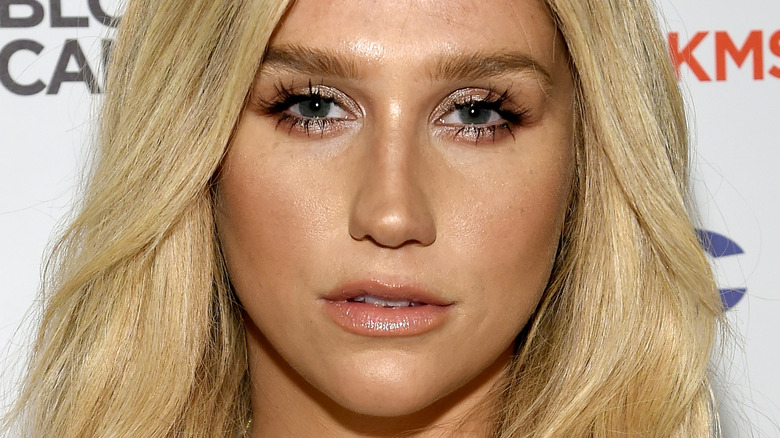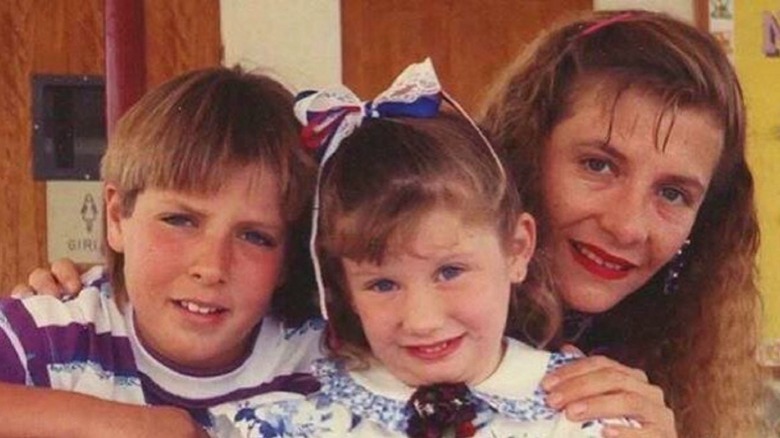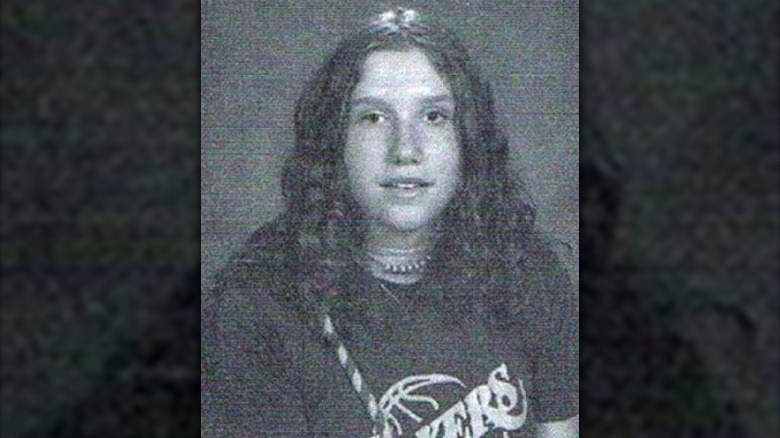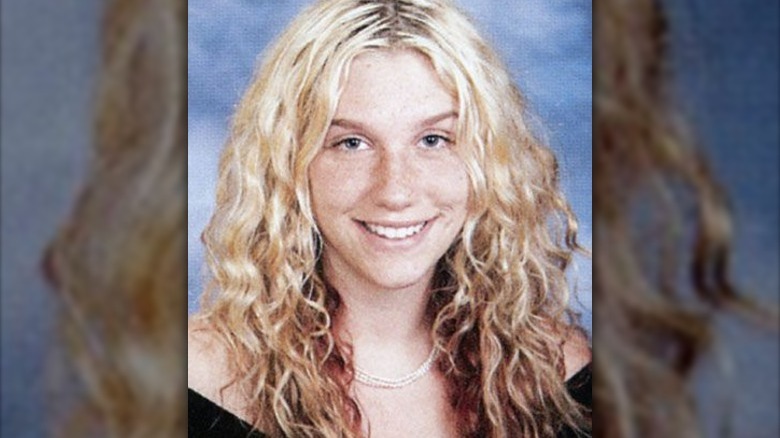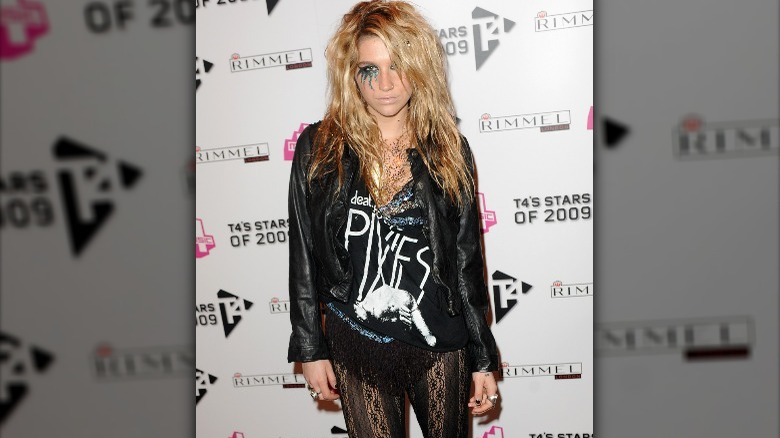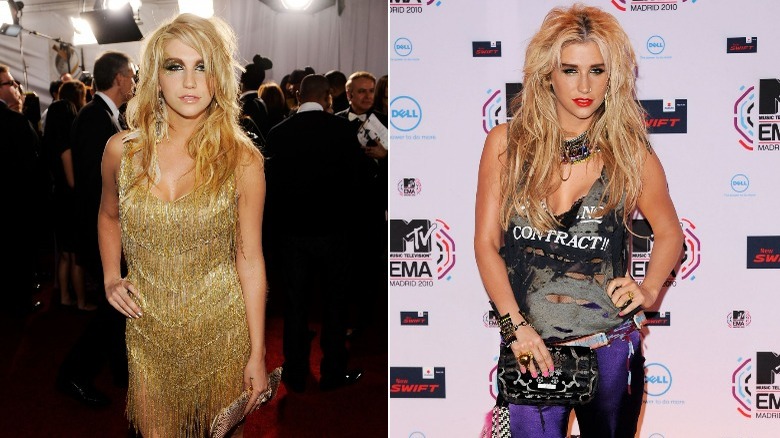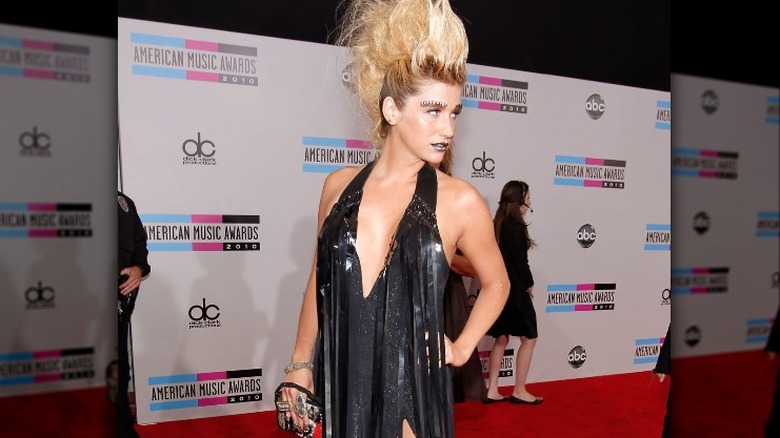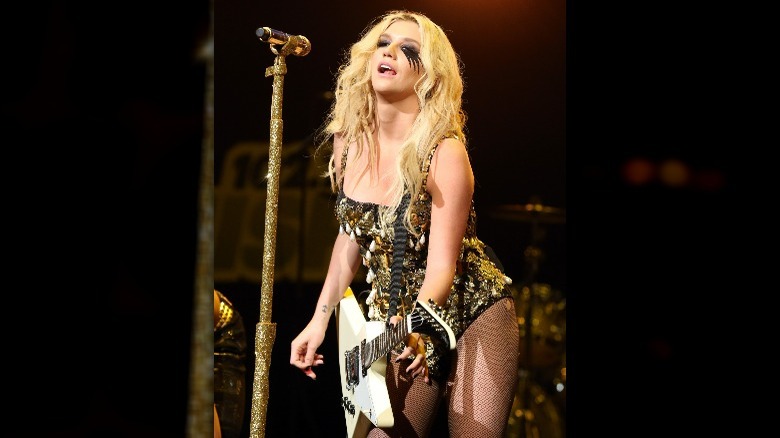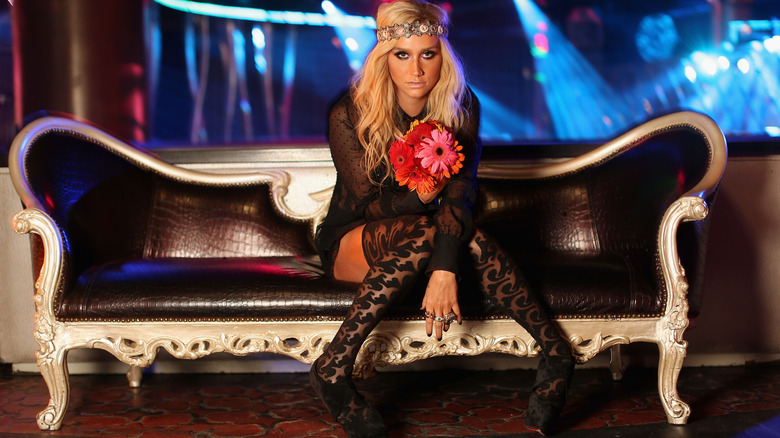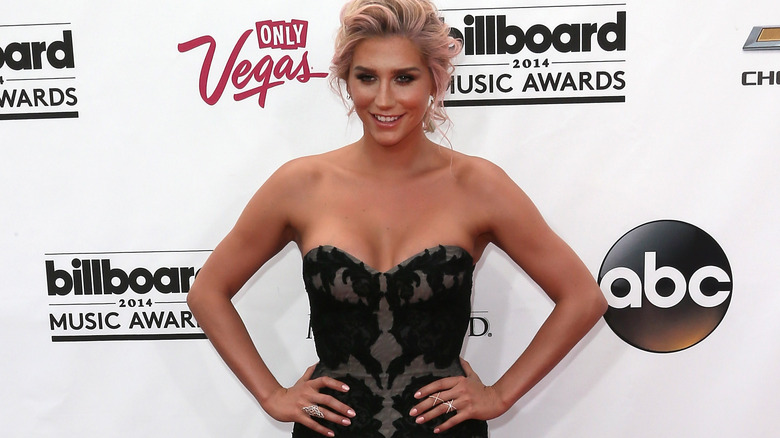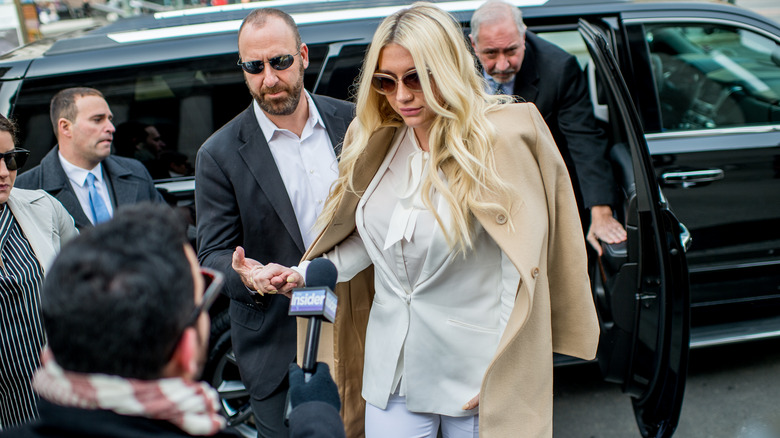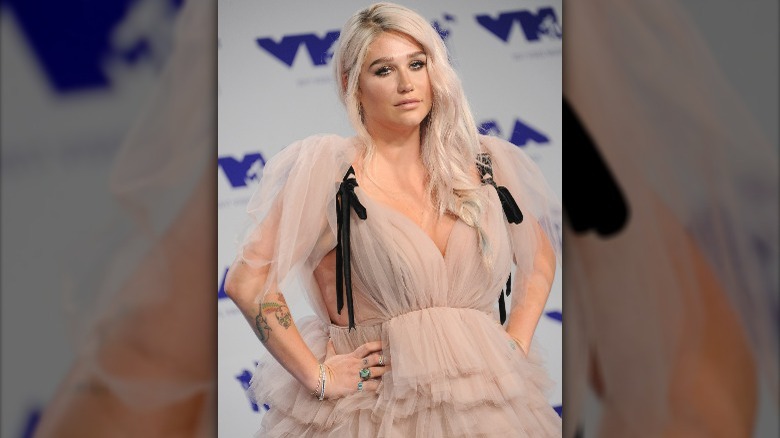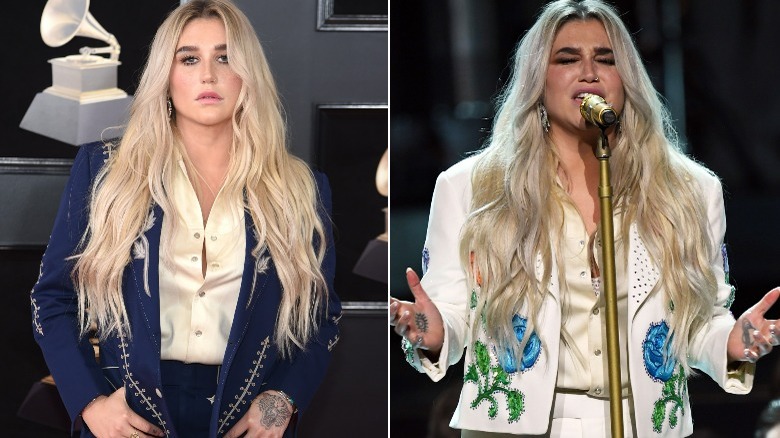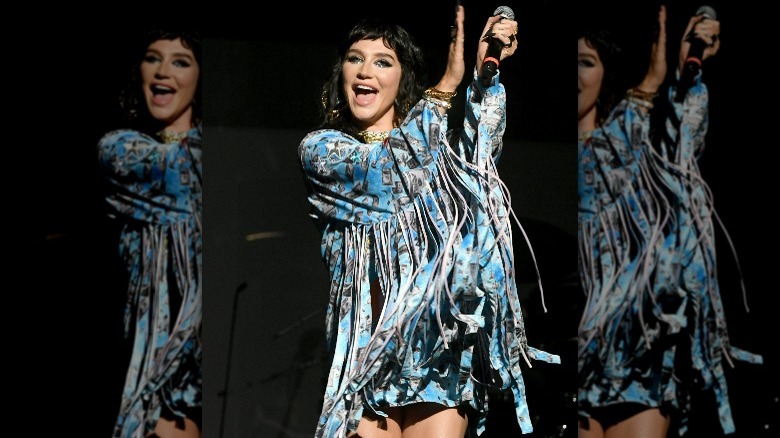The Transformation Of Kesha From Childhood To 34
This article contains references to sexual assault, abuse, mental health issues, suicide, and eating disorders.
Ever since she woke up in the morning "feeling like P Diddy," the transformation of Kesha has seen the star embracing the opportunity to wake up feeling like herself instead, and loving it. Having once described her style as "garbage-can chic" to Entertainment Weekly, the "Blah Blah Blah" performer with a penchant for gutter-chic punk styling has long understood the significance of taking something other people regard as trash, and making it valuable.
"I love making something beautiful out of things that others have thrown away," she wrote in her autobiography, "My Crazy Beautiful Life." It could be argued that over time, she fought hard to treat herself with that same care, too. Particularly because, as much as Kesha has succeeded, she has also allegedly been cruelly dismissed and discarded throughout her career.
In the most symbolic visual of this ethos, the star once told Spin that she wore a necklace of her own placenta — something that her "mom found in the basement, crushed up," to make the jewelry item. It's telling that the piece, which she named as her "favorite keepsake," is a literal former part of herself. An anchor, perhaps, for the times where it feels like she's being dragged into darkness by the violent chops of life's persistent torrents.
Luckily, just as her "TiK ToK" lyrics teased, she was always ready to fight 'til she saw the sunlight. This is the transformation of Kesha, where she did exactly that...
Kesha's musical childhood
The foundations of the superstar born Kesha Rose Sebert can be glimpsed in her Nashville upbringing. Described by Rolling Stone as "an artsy kid, from a quirky family," the star claimed to know "she wanted to be a singer from the age of two." She came from the perfect stock to dream of such a thing. Her mom, a tenacious singer-songwriter by the name of Pebe Sebert, had written songs that were performed by country stars including Dolly Parton and Johnny Cash, per WWD.
As a single mom, Pebe would often take Kesha and her two brothers along to the recording studio while she worked, per The Guardian. Naturally, the young star-to-be soaked up the atmosphere and learned the foundations of her passion. "My mother taught me how to write," she told the outlet, "When I was younger, she was always, like, 'Don't write fake stuff. People can tell if it's not real.'"
One particular truth of Kesha's upbringing that she never shied away from openly expressing was what the outlet described as her "happy but impoverished upbringing." The family subsisted "on welfare and food stamps" for some time, but it didn't change anything for the musician. As a happy child living in a household of financial restraint, she realized early that "there is no correlation between happiness and amounts of money," as she told The Guardian. Her irreverent gutter-pop persona would soon joyously embody that sentiment.
High school dropout
But first, she had to survive middle and high school — a troublesome feat, considering that Kesha "always looked like a f***ing weirdo" there, as she professed to Entertainment Weekly. She wore homemade "purple velvet pants" that she matched with purple hair, a look which her "Bible Belt" classmates didn't exactly warm to. She told Rolling Stone, "I refused to conform, and they refused to be nice." Her school experience was so bad that the singer "took to eating lunch in the bathroom."
Luckily, music gave her an out. And while she "plotted music videos from the age of nine," according to the outlet, she was also seriously writing and recording music. Per The Guardian, Kesha was all set to study comparative religion and psychology when her music was discovered by hot-shot producer Dr. Luke, and she was offered a record and publishing contract she couldn't refuse. "I quit school and moved to L.A." she told the publication, "and since then I've forgotten everything about Pythagorean theorem."
As though the universe were conspiring for Kesha's burgeoning sense of celebrity, the 17-year-old's life-changing opportunity was initially answered by Nicole Richie. Per Billboard, the Sebert household was playing host to an episode of "The Simple Life" when Luke first called to show interest in signing the teenager. Naturally, "Richie hung up on him." Still, it didn't stop fame from finding Kesha, who signed to Luke's label, as well as his publishing company, once she turned 18.
Broke and in the background
Now living in Los Angeles, Kesha pursued her music career — but found it mysteriously lacking for five long years. Just as she thought she was going to have an opportunity to share her voice, she was instead lending it to others by writing hits for artists including The Veronicas and Miley Cyrus. It wasn't exactly a lucrative venture. As she shared in the lyrics to her 2012 song "Wonderland," the star scraped by in L.A. by periodically living out of her car.
Per Billboard, "[Dr.] Luke was busy with his burgeoning production projects," and Kesha "rarely worked with or even spoke to" him for years. Any other stalled superstar would be frustrated, but Kesha used it to her advantage and embraced her low income. In fact, she reveled in it. In 2010, the star told The Guardian that some of her "favorite memories" happened in "that crappy bar" where she used to hang out with her friends, eating tacos for free with every shot of tequila. Hey, a girl's gotta eat.
As ever, Kesha knew how to make the best out of a situation that polite society may have considered bad. The star would soon double down on her garbage-glam persona by adding a dollar sign to her moniker — an "ironic" gesture because she "was so broke" at the time, she told Entertainment Weekly. It would become a fierce finger flip to an industry which seemed keen to devalue her.
A featured artist -- without pay or credit
For whatever reason, the powers that be decided that Kesha was better off broke. In 2009, she finally landed the breakthrough hit she deserved — as a featured artist on Flo-Rida's record breaking hit "Right Round" — but didn't see recognition or money for her contribution. "I didn't get credit, I didn't get paid," Kesha told Entertainment Weekly. In a classic example of her turning trash into treasure, she brightly noted to the outlet, "It's like, 'You know what, if you don't want to pay me, it's fine. I'm excited to have my voice on the radio.'"
The reality of the situation sounded devastating, however. Speaking to The Guardian a year later, she explained how, at the time, she "didn't even have enough money to buy [her] groceries in ... the dollar store," and yet she heard her vocals "everywhere" via the hit. Despite the professional slight, Kesha was regardless "a hot commodity," as Billboard put it, and she subsequently signed a multi-album deal with RCA Records off the back of the track.
Having found her voice, Kesha also settled into her style. Looking like she'd started the night at a punk gig, but ended it at a rave, the singer's glitter-grime style projected her keen survival instinct: On the one hand, she was draped in the mysterious darkness of black-on-black garb. On the other, with her rich golden hair and glitter streaked face and body, she was defiantly dazzling: her own light and shadow.
The party don't start 'til Kesha walks in
With her debut album, "Animal," Kesha had leapt out of her cage and into the wild of the music industry. Blowing up speakers with a sound that Entertainment Weekly described as a "Valley Girl sneer" paired "with electro-glam arrangements," Kesha became a party pop sensation. Despite having reservations about rapping on the album (she told Billboard, "The white-girl rap swagger thing is really a little bit of a joke"), she nonetheless went with the auto-tuned, conversational sound — and scored a number one hit with "TiK ToK."
There was a freshness to Kesha's sound and look, which can likely be traced back to her diverse set of influences. They included psychedelic punk outfit Butthole Surfers, provocative post-punks The Fall, and Daft Punk, according to her MySpace page (RIP, via Vice). Speaking to Elle, she further added that Beastie Boys were a potent — if obvious — spirit in her musical cocktail, explaining that when she first heard "(You Gotta) Fight For Your Right (To Party)," she responded, "I wanna participate in whatever this is."
And she did — in a chiaroscuro wardrobe as diverse and eccentric as her musical influences. Whether she was wearing a gold Nicolas Jebran fringe dress (above, left) or a torn punk look which looked like the fashion roadkill of Avril Lavigne (above, right), Kesha looked like a woman capable of balancing her professional responsibilities with her immortal vow to simply have fun.
Kesha's Santa Carla vampire moment
As a young woman extolling the virtues of partying harder than Andrew WK and treating men with the same lip-licking objectification as male singers have with women, Kesha garnered some critics. "I have so many people who hate me, it's unbelievable." she told The New York Times in 2012, adding, "There's people who want me to die." By all accounts, there was an obvious double standard at work against her, and she was more than savvy to it.
Discussing the more carnal side of her persona with The Guardian, Kesha said, "People are shocked by it, but if I were Guns N' Roses or Van Halen, no one would be surprised." Still, Kesha didn't seem to care too much about other people's opinions of her — as exemplified by her out-there look at the 2010 American Music Awards. Wearing the "insides" of a VHS copy of "The Lost Boys," the star wanted to set the tone for a "hot" vampire-inspired performance, which championed gender fluidity in "a celebration of being yourself," per Spin.
But musically, was Kesha being herself? Though her spirit screamed rock, her music was less so. Her second album may have been reviewed favorably, but there was an edge of insult to the compliments. The Boston Phoenix, for instance, proclaimed, "It takes brains ... to make pop this smart sound so dumb." It was time to level up — but she'd have to fight for it.
Deranged for rock 'n roll
At the end of 2011, Kesha collaborated with shock-rocker Alice Cooper on a track for his album, "Welcome 2 My Nightmare." Discussing the unexpected pairing with The Guardian, the "Poison" performer described his duet partner as having the "stature and attitude" of a rock icon like Robert Plant. Kesha didn't shrink from the comparison and suggested, "I have a rebellious, metal-loving rock chick inside of me. This song is the world's first look at the evolution of that."
The next stage of her evolution came in the shape of her third album, "Warrior" — a rockier effort which "crystallizes Kesha's defiance," in both sound and title, per The New York Times. "It's about being fearless, about fighting for who you are and not letting anybody else break your spirit," she told the outlet. It was a curious statement, given that a damning New Yorker profile on Dr. Luke had suggested, "Relations reportedly became strained" between him and the singer during the making of "Warrior." She wanted to go rock, while her team allegedly wanted her to continue being a party-girl pop princess.
Tellingly, the highlights of the album are the tracks where Kesha is apparently living her truth as a rocker, including an appropriately sleazy duet with the Godfather of punk, Iggy Pop. But, as The Guardian noted, the album wanes in the moments where her former sound awkwardly lingers — such as the over-abundance of auto-tune distorting "Kesha's voice into a robo-squawk."
The 'Free Kesha' movement begins
On "Warrior," Kesha's voice was accused of being unnecessarily manipulated into an automated shriek. But, a year later her fans were accusing Dr. Luke of likewise manipulating the star into a restrictive pop persona that she deserved the right to break free of. A petition signed by 12,340 fans claimed, "Dr. Luke is controlling Ke$ha like a puppet," and accused the producer of "stunting her [growth] as an artist." There was, sadly, some potential proof to support the rumors.
According to MTV, "a pair of unreleased (and decidedly De-Lukeified) demos" had been leaked showing the singer "flying her freak flag [while showcasing] her voice rather than the Good Doctor's studio polish." That same year, a collaboration album between Kesha and The Flaming Lips was announced and then promptly canceled due to mysterious contractual issues. Speaking to NME in 2014, the band's frontman Wayne Coyne suggested that Kesha had told him at the time — hopefully jokingly — "I can't put this music out, Dr. Luke will kill me."
Addressing the situation with Rolling Stone, the singer suggested that on top of feeling like she had no creative autonomy, she also didn't want to turn into "a parody" of herself by releasing "the same song" over and over. She also suggested that an inaccurate "image" had been established via her music, and there was a lot more to her that she wanted to share. Kesha was ready to reintroduce herself, and she would.
The start of Kesha's journey back to herself
The final major transformation of Kesha began with her choosing to practice what she preached. "I'm a crusader for being yourself and loving yourself but I've found it hard to practice," she said to People, in a statement. The outlet reported that the "Timber" star had entered a 30-day rehab for an eating disorder, one that had "nearly killed her," according to Rolling Stone. In the background of her suffering was the great shadow of a potentially strained career which she inferred left the proud outcast feeling pressured to fit in.
"I felt like part of my job was to be as skinny as possible," she wrote for Elle UK, "and, to make that happen, I had been abusing my body" (via Rolling Stone). Kesha's mom, Pebe Sebert, was more specific in where she pointed the blame for her daughter's health condition. Speaking to People, she accused Dr. Luke of "telling her how she had to get in shape and lose weight." The singer wasn't getting the desired results "fast enough" — making her bulimic. Luke denied the allegations, calling them "unfortunate" (via Vibe).
Following her time in rehab, the singer looked healthy and radiant with a crop of rose-tinged hair paying reference to her middle name. The symbolism was significant: Kesha had finally dropped the dollar sign from her moniker, and with it she bid farewell to a "facade" of her former persona, telling a Refinery 29 panel, "It was total bull***t."
If you are struggling with an eating disorder, or know someone who is, help is available. Visit the National Eating Disorders Association website or contact NEDA's Live Helpline at 1-800-931-2237. You can also receive 24/7 Crisis Support via text (send NEDA to 741-741).
Kesha versus Dr. Luke
A few months after getting healthy and dropping her former "facade," Kesha filed a lawsuit against Dr. Luke which would change everything. In 2014, TMZ reported allegations that the producer had been abusive toward the singer "from the get-go — when she signed on with him at 18." The lawsuit claimed that the producer had physically and sexually assaulted the star on various occasions, and also plied her with drugs and alcohol prior to some incidents. The purpose of the lawsuit, her lawyer noted, was an effort "by Kesha to regain control of her music career and her personal freedom," per the outlet.
In an affidavit from 2015, Kesha alleged that the producer's violence against her was also psychological, with Luke reportedly controlling aspects of her life and career. "I was too young and naive to even understand what he was doing to me," she explained (via Billboard). Luke denied the accusations and filed a counter complaint, with his lawyer suggesting to USA Today that the singer's "scurrilous" and "false" claims were included in a "campaign of publishing outrageous and untrue statements."
Then, in 2016, a judge denied Kesha's petition to leave her contract with Luke, "prompting the pop star to break down in tears," per BuzzFeed News. The judge reportedly claimed that "releasing Kesha from the contract under Sony would cause irreparable harm" if she did not complete her obligatory remaining albums. The courts could deny her, but they certainly couldn't silence her...
If you or anyone you know has been a victim of sexual assault, help is available. Visit the Rape, Abuse & Incest National Network website or contact RAINN's National Helpline at 1-800-656-HOPE (4673).
If you or someone you know is dealing with domestic abuse, you can call the National Domestic Violence Hotline at 1−800−799−7233. You can also find more information, resources, and support at their website.
Kesha's guttural empowerment album
Recoiling from the devastation of the judge's decision — and a legal battle which is ongoing, as of this writing — Kesha revisited her modus operandi, and made something beautiful from the ruins. She told The Guardian that her next album, "Rainbow," was salvaged from the debris of her trauma and legal crusade, declaring, "This is truly from the inside of my guts." Speaking to "Good Morning America," she went one step further and announced while wearing a defiantly vibrant neon-lime suit with a hot pink shirt, "This record has, quite literally, saved my life."
In the music video for the album's lead single, "Praying," she folded herself into a healing cacophony of color, rocking a regalia of glam rock staples which made her resemble her own sparkling deity. As indicated by the song's lyrics, she'd chosen empathy over anger — and her style and music emerged as a spiritual manifesto for such kindness, in the wake of despair.
Hate, she wrote for Lenny Letter, "will just create more negativity." She was now choosing joy, and urged others to survive similar hardships, just as she did, writing, "Don't let anyone steal your happiness!" The dramatic Monsoori multi-tier tulle dress she wore to the 2017 MTV VMAs (above) was a further reflection of her newfound philosophy: Soft and vulnerable, the washed-out rose color made her look like a pressed flower in the good book of Kesha — delicate but persevering. And incredibly, about to bloom once again.
If you or someone you know is struggling with mental health, please contact the Crisis Text Line by texting HOME to 741741, call the National Alliance on Mental Illness helpline at 1-800-950-NAMI (6264), or visit the National Institute of Mental Health website.
If you or anyone you know is having suicidal thoughts, please call the National Suicide Prevention Lifeline at 1-800-273-TALK (8255).
Kesha breaks new ground at the Grammys
Roses would continue to become Kesha's style staple of a statement as she pushed forward into 2018. For the Grammy Awards, the star wore two sets of country-inspired suits, both boasting roses on the lapels (above). As noted by Allure, the flower was a universal symbol adopted by celebrities to show support for the Time's Up movement, and Kesha had hers stitched in, not just pinned. For the singer, Time's Up was less of a statement on her lapel, and more of an indelible part of who she was, and what she'd experienced.
As her stylist told People, this wasn't just a Time's Up statement, it was her life, stating, "[Kesha] lives that story." To boost her confidence for the event, they chose a suit by which she could avoid being "objectified in a dress," and instead "own her place as a woman and be empowered." On the Grammy's stage, the star continued to make a statement. Flanked by a battalion of female artists including Cyndi Lauper, Bebe Rexha, and Camila Cabello "all wearing different outfits in suffragist white," Kesha performed "Praying" — and delivered what The New York Times described as "an unmistakable visual statement of solidarity."
Introducing the performance, Janelle Monae prefaced the visual with a statement which could have doubled as Kesha's mantra for the moment: "We come in peace, but we mean business." For the singer, finding peace was now her business — and business was good.
How Kesha got her groove back
Getting to a place where she could find peace allowed for Kesha to finally reclaim her voice and her happiness. Speaking to The Wall Street Journal, she explained that her next album, "High Road," had rightfully clawed back her "party-girl persona" for her own. It was an attempt, she said, "to showcase all sides" of herself, the vulnerable and the joyful. "I realized I wanted to have the next chapter be really fun and positive and poppy," she elaborated to Insider, "...I don't think that I owe it to myself to stay in a place that's just, like, sadness."
The result was a critically acclaimed grandslam of a pop album — one which The Independent mused was like "the album equivalent of someone who can finally handle their liquor." The party-girl was still there, but this time she could reflect on her melancholy rather than crush it beneath hedonism. Instead, she made something jubilant and gratifying from her raw anguish, serving tracks which asked the question: Why cry when you could dance?
And dance she did. Like the glitter she once assured Entertainment Weekly "fixes everything" if you smear enough of it on, the singer shone in the darkness. For the next confident phase of her career, Kesha reunited with every side of herself. Folding the dark into the light, the sardonic with the optimistic, and the provocateur with the healer, she refused to be discarded or dismissed — and instead, she made something beautiful.

